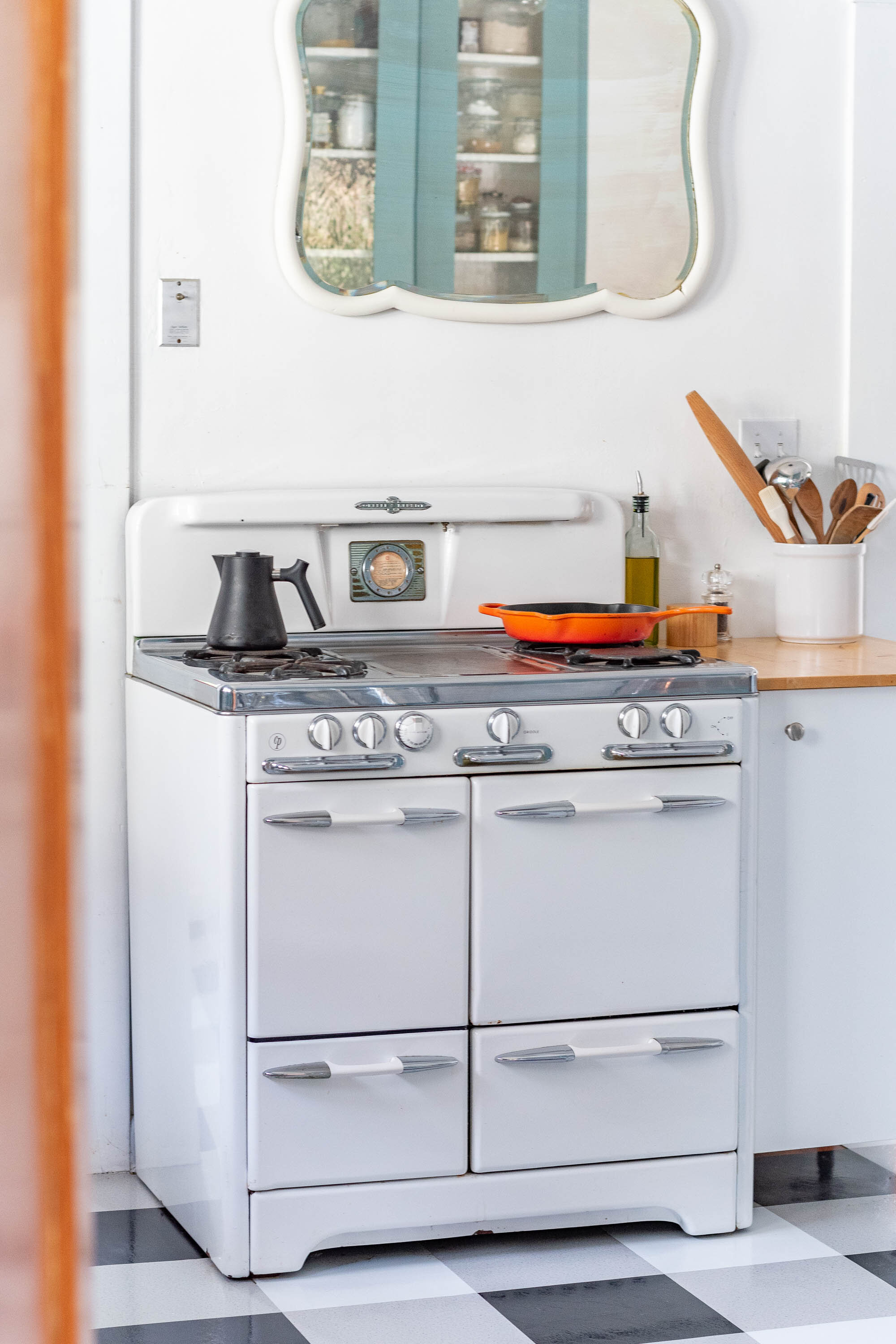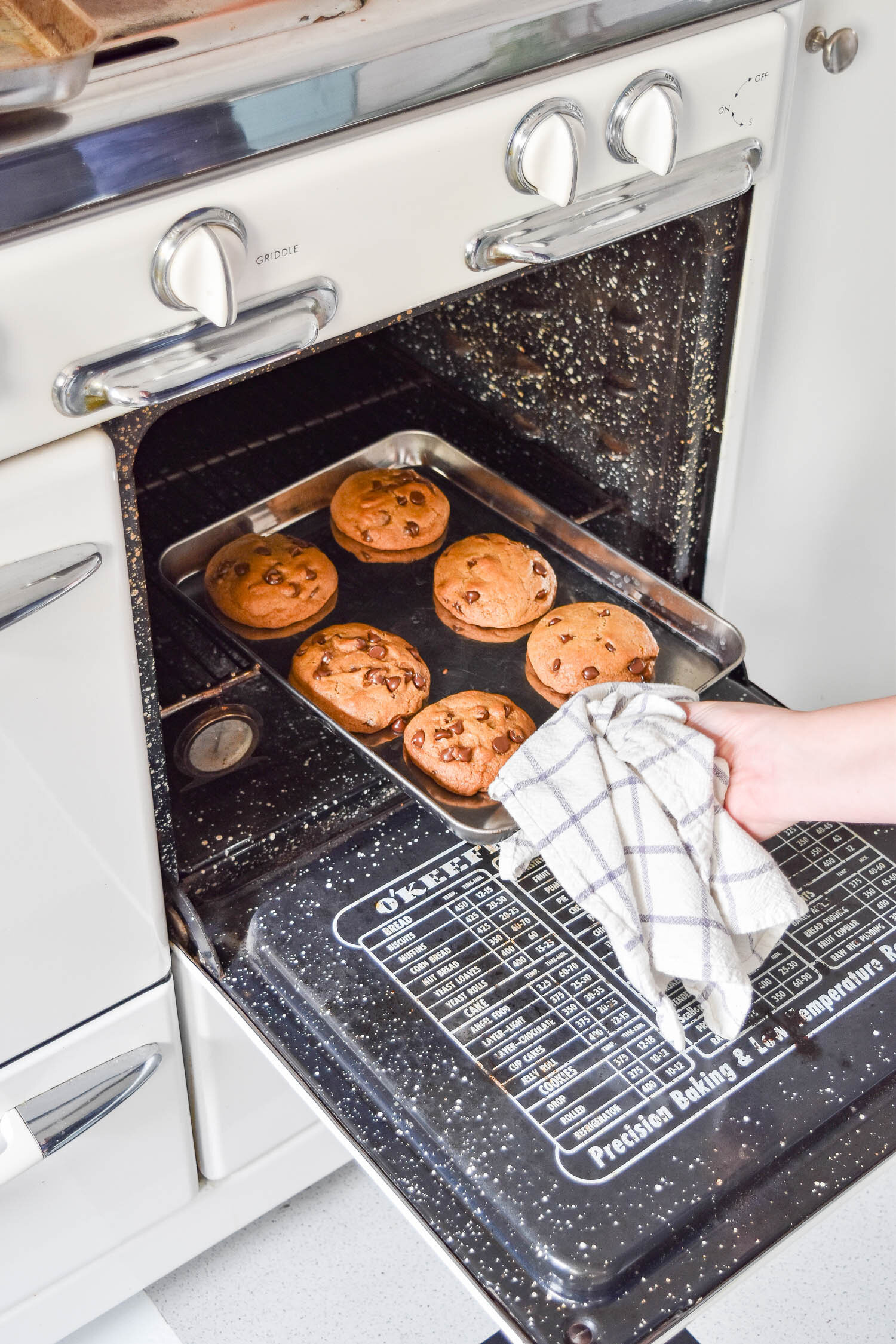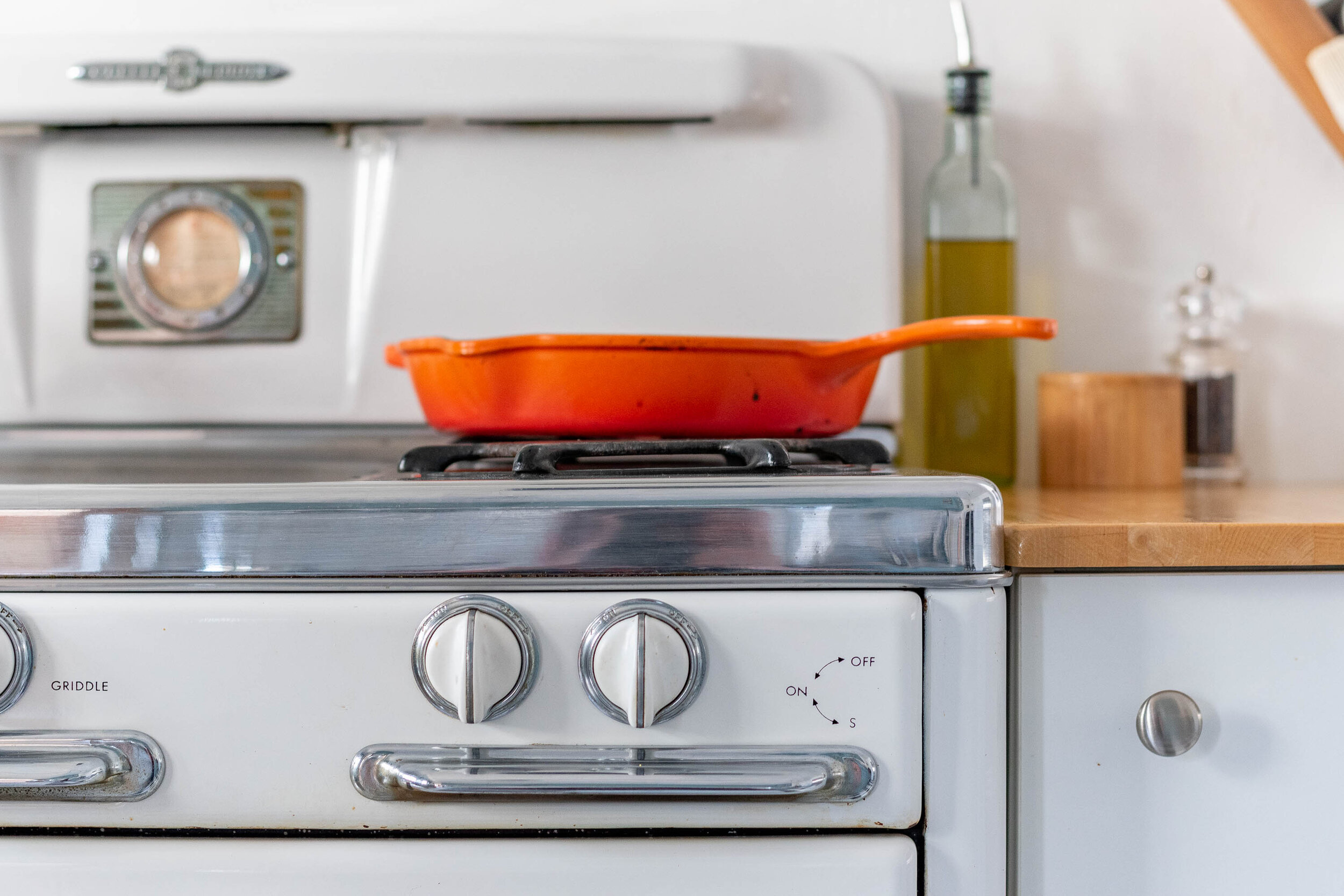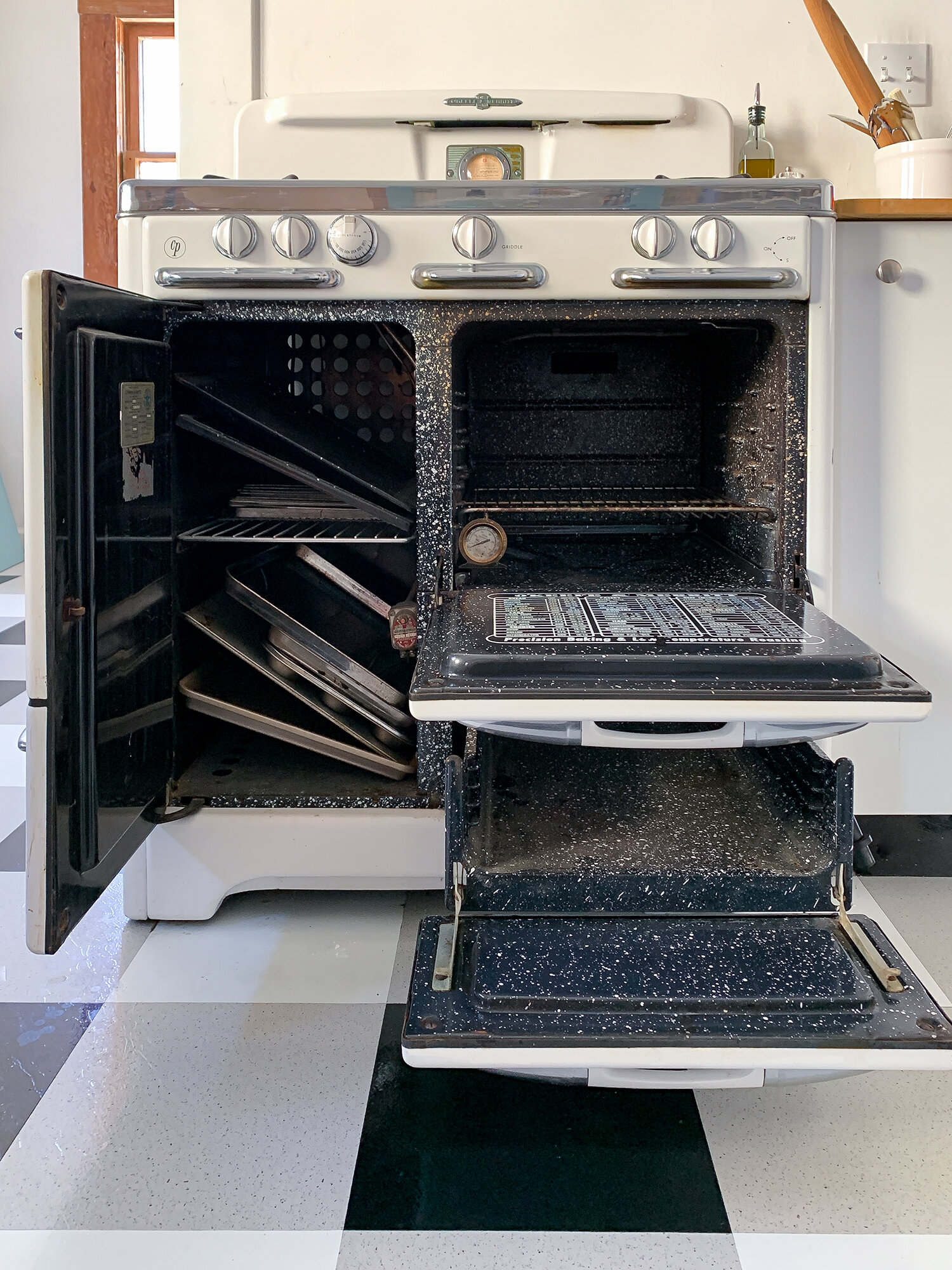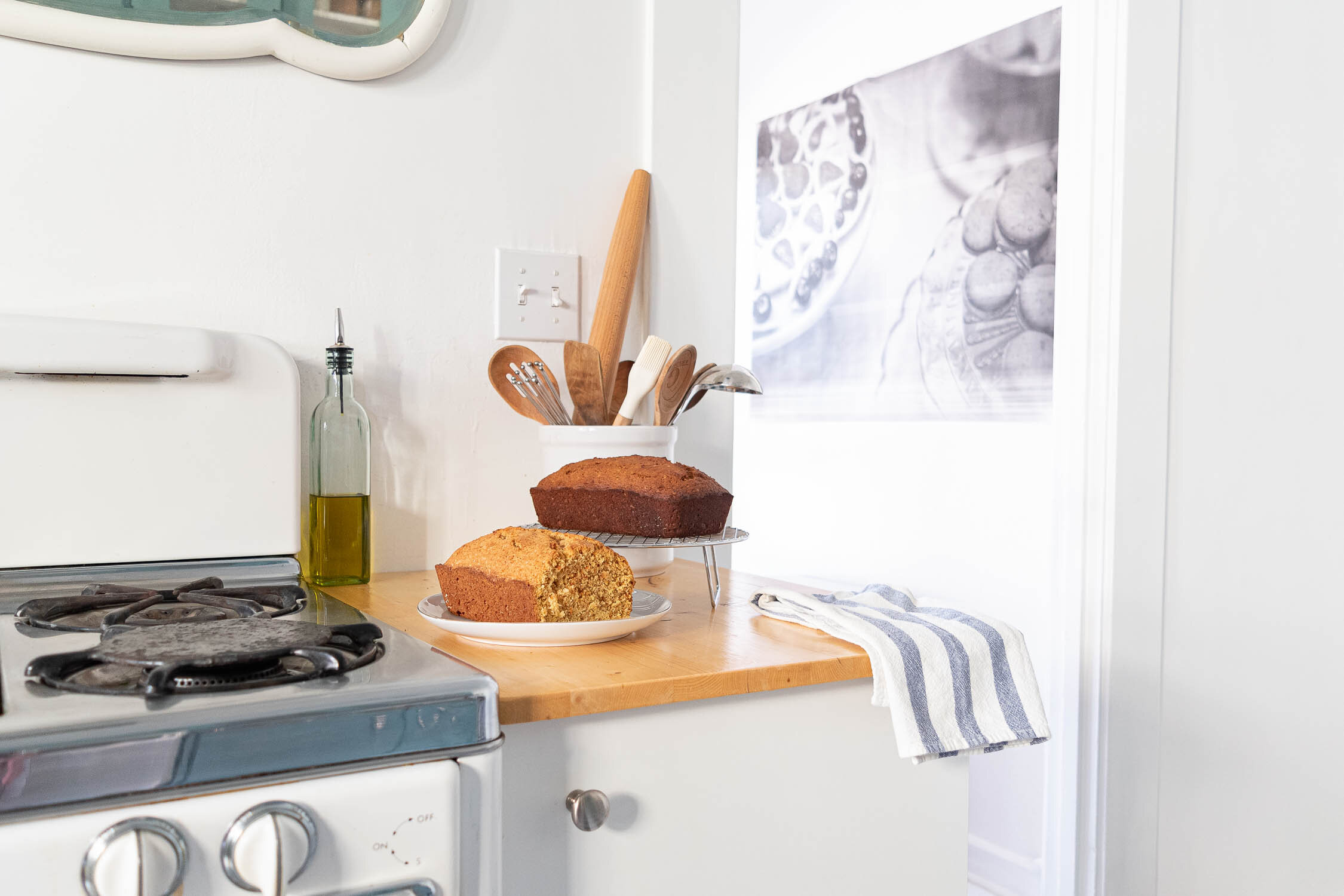My Experience Living with a Vintage Stove - The Pros, Cons, and Answering, Will We Get Another Old Range?
/I’ve been asked a lot about our vintage O’Keefe & Merritt range. I get it, she’s a cutie! For some people, an old stove is a foreign idea so there are a lot of curiosities about how we’ve used, cared for, and enjoyed our old range. So I’m here to share all that now.
We have an O’Keefe & Merritt stove that’s all gas (both cooking and baking) and was made and sold in the mid-1950s. She’s 70ish years old and still going strong.
Longevity
These old ranges are built pretty well and are relatively simple to repair when they need extra love. They’re made of materials that can be refinished and the parts are modifiable or replaceable. These puppies aren’t designed with planned obsolescence the way our modern appliances are today.
Baking
I’ve made some mighty good recipes with this range. I even got that perfect brown on the tips of the meringue with just the broil setting in the oven. No fancy culinary blow torch required. Speaking of those recipes, check out my vegan chocolate chip cookie recipe and my favorite lemon meringue pie recipe. I’ve become known for making some pretty mean pies and I bet the oven is to thank for it.
Features
There’s no fancy built-in temperature probe, or fan, or steam function - there isn’t even a temperature gauge, and there definitely isn’t a timer. I know these are features that are expected on new appliances, but I honestly don’t even get excited about the thought of these because I’ve learned to cook without them. I can imagine how going from a modern range to an antique range would feel like a “downgrade” but I really don’t see using an antique as lesser than. It’s all a matter of perspective.
Power and Replacement Parts
The stovetop also cooks us some pretty great meals, too. It’s just as powerful as modern-day ranges and if anything, it can be too powerful when trying to get a mild simmer. Our range has a griddle feature that we never used because the finish was worn off and I didn’t feel comfortable putting food on the surface with different layers of coatings. I got a bid to re-plate it for $150 but I just never did it. I wish I did because I love a good pancake cooked on a griddle.
When we first set the stove up years ago, we had some issues with the pilot lights, but I just lifted up the top, moved a metal tube over a quarter of an inch, and we were in business. Remember what I said about how things are pretty easy to fix? That’s what I’m talking about.
As someone that doesn’t eat meat, I never ever consult the cooking recommendations printed on the stove, but I must admit that the two cooking guides are pretty darn charming.
Size and Features
There are a bunch of compartments on the front of the range, but the only one we really use is the main oven in the upper right corner. The left side is all storage, and the bottom drawer we use for roasting every once in a while.
I’ll admit that the main oven is pretty little. It won’t fit standard-size trays nor will it cook multiple big entrees at once. But, it’s worked well for us. We tend to stagger our bakes by putting in veggies to roast at 450 for an hour, then backing a pie at 350 after the veggies come out. I’ve only once or twice wished I could fit more. And I easily could if I bought another rack - but I’ve been too lazy to do so.
A feature I like that’s pretty subtle is that there’s no fan in the oven. So when we’re baking, it’s silent. I know some modern ovens have a whirring noise that goes on the whole time it’s on, so it’s nice to be without that.
My range is pretty simple. There are lots of other antique stoves that have unique functionality like grillevators, built-in crock pots, salt and pepper storage, a vanishing shelf, and more.
Needless to say, these appliances don’t have smart home connectivity to control it from your phone or program it to cook something based on a recipe stored in your app. They don’t have touch screens or computers or any fancy tech. And I’m glad! Those are the first things to fail in appliances, and a faulty piece of tech can make the entire unit unusable.
A feature of old ranges is that they are pretty on all three sides so they are great standalone appliances if you can’t have or don’t want cabinets on either side. Isn’t she pretty?!
Safety
The con I experience most is I tend to burn myself a lot. It’s definitely more of a me issue than something I can blame the oven for, but it happens nonetheless. I often singe my arm when I’m reaching into the narrow oven. It’s small and the racks don’t pull out easily so I tend to shove my whole arm in and end up bonking it on the side.
Also, the insulation isn’t the greatest, so the exterior gets pretty hot. When baking at a high temperature for a good amount of time, the knobs become too hot to touch, the door is scalding, and the sides are pretty warm.
Cleaning
Cleaning the stove can sometimes be a challenge with all the grooves and compartments and hinges and stuff. But I don’t imagine it’s much worse that a modern day appliance. The nice thing is all of the knobs pop off! I particularly like the crumb trays! Those three horizontal chrome pieces on the front under the knobs are trays that collect crumbs that fall through the stove grates. They slide out and are easily walked over to the trash/compost and then get rinsed off. Genius.
These ovens don’t have self-cleaning modes. Which honestly, I’m happy with because I’m not a huge fan of incinerating the grime and having noxious smells waft through my house.
Environmental Impact
The greatest reason to use an antique stove, in my opinion, is that it’s environmentally friendly to employ something that already exists. The appliances were built to last and with proper maintenance will last another 70 years. The thought of sending one of these to the dump just to replace it with a new one hurts. And those new mass-produced ranges were designed with planned obsolescence, constructed with new materials extracted from the earth, assembled in a factory with potentially poor working conditions, trekked across the globe consuming fossil fuels, then installed with the plan for them to only last 10 years until an irreplaceable part dies. It’s just not a great replacement.
On the other hand of the environmentally friendly perspective, gas appliances aren’t great either. Natural gas is a fossil fuel and a non-renewable resource. There’s a move to replace appliances in new construction homes with all electric power because those appliances can be powered by the sun, wind, or other renewables (gas can’t be powered by these). There is also talk about the negative health affects of burning gas inside of our homes. Learn more about this here from The New York Times and here from USA Today.
All that said, there are plenty of antique stoves that are powered by electricity!
Pros and Cons of a vintage stove
Cons:
Gas appliances can’t be powered by renewables (but old electric ranges exist!)
Cooking capacity tends to be small
Can run hot and can be burn hazards
Lack features that some people have become accustomed to with modern appliances
Pros:
Stylish and adds instant character to a room
Environmentally friendly by using what already exists
Made of materials that can be refinished and parts that can be replaced
Includes unique retro features
Built to last and will continue to last
No noisy fans or tricky electronics to maintain
Quality bakes and powerful cooking
Cheap to buy used
And now for the question I get asked all the time:
Will we be keeping this range when we remodel?
Simply, no. It’s cute, I love it, and it’s served us well, but it isn’t the range we want long term. So many people say “oh it fits the period of your home so well!” but it really doesn’t. Our house was built in 1915 and this was built in 1960. Sure, it’s old, it has history, it’s charming, but it isn’t exactly fitting of our home’s style. Now, I’m not saying that I’m trying to make our future kitchen look like a 1915 house museum, not at all. But, I do want to put that out there.
We have a different range lined up and I’m excited to share my reasoning and purchasing tricks for it one day. Stay tuned!
Want to buy an antique range for yourself?
Yay! Old appliances are so so cheap compared to modern day ones. You can get one of these puppies for $100 bucks if you’re lucky! Many go for $300 in great condition or $500 fully refurbished. What a deal compared to new appliances that run $5,000 for comparable style and size.
Check your local Craigslist, Facebook Marketplaces, antique shops, and stores near you. Try asking your local architectural salvage spot if they know of any local appliance refurbishers to see if you can buy one fully restored. Or, get the name of someone that will do the restoration work of re-plating or sandblasting. You’ll likely need to ask around to find just the right guy for one part of the restoration work and just the right gal for another part. If you can’t find a local seller, check eBay or Etsy.

